|
The Paffard Years
1852 - 1898
 
Henry Paffard
Upon James Harvey's untimely death in the Fall of 1851, Henry Paffard, thought to have been an apprentice of Harvey's, briefly operated the pharmacy for Harvey's widow, then bought the practice and officially took it over in early 1852. Paffard's 19-year old brother, Charles, joined him as an apprentice, while Henry himself seems to have benefited in many ways by association with his own father, Frederick, a pharmacist in St. Catharines.
In 1860, Paffard moved the pharmacy to another location on Queen Street to within a few doors of its present corner location and near his own noteworthy Paffard business block. In 1868, he purchased its present location, which was then the office of lawyer, later Judge E.C. Campbell. In Campbell's time the building, which dated from the 1830's, had served a variety of different purposes.
Prior to moving his practice, Paffard made major changes by extending the building to the street line, lowering its floor to street level and raising its ceiling. In other words, before he moved to this new location, Paffard literally arranged to expand the structure in every dimension. Prior to moving his practice, however, Paffard was clearly determined to provide the townsfolk and visitors with a most imposing structure, interior and exterior, described by the restoration architect Peter Stokes as "mid-Victorian Eclectic."
The counters were of black walnut and the elaborately carved dispensing unit, butternut, made by a Toronto cabinet-making firm that also supervised local craftsmen in constructing the other wooden fixtures.
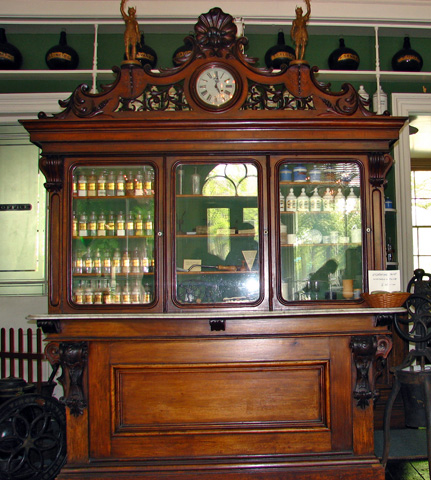
The dispensary (seen above) is eminently Canadian, with its resident beaver carved in a conch shell at the top centre. Below the conch shell is a clock, dated 1866, made in Albany, New York, which remains in working order, but now battery operated rather than hand wound. On either side of the above are exotic gilded figures that definitely don't appear to be Canadian, but rather Amazon women warriors who hold aloft lighted globes. In Paffard's time the globes were apparently of colored glass, from surviving evidence most likely green and red, like the ever present show globes; and they were lighted originally by gas generated on the premises, as were the elaborate crystal gasoliers.
The dispensary itself has a surprisingly small working area, even though it is covered with a slab of white marble (seen below, with the first pharmacist greeter, G.W. "Pete" Fairley.) The size is odd considering all the activity with sometimes complex, multi-ingredient prescriptions filled as presented, as well as the sheer volume of the crude drugs in the bins and drawers, and the partially prepared pharmaceuticals in the jars and bottles on the shelves that fed all the prescriptions and other preparations executed there.
 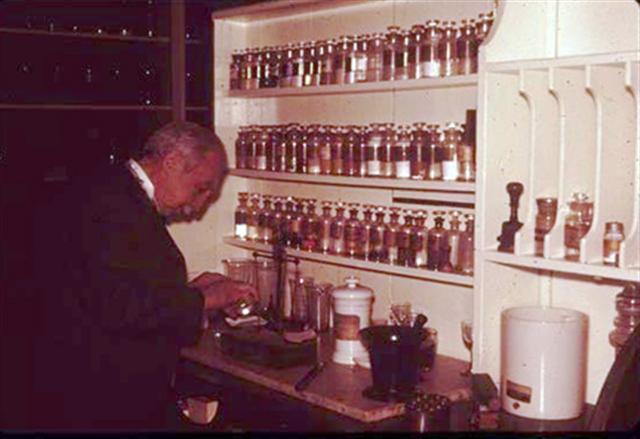
Ornate gilded plaster medallions in the lofty ceiling held elaborate crystal chandeliers—strictly speaking "gasoliers," lighted by gas generated on the premises, in the basement. The plaster work was done by Italian craftsmen traveling the country doing mostly large public buildings, according to restoration architect Peter Stokes. The plaster rosettes, according to him are in an "elaborate undercut design of fruit and flowers with intertwined basketwork in the larger one toward the back" of the pharmacy (below).
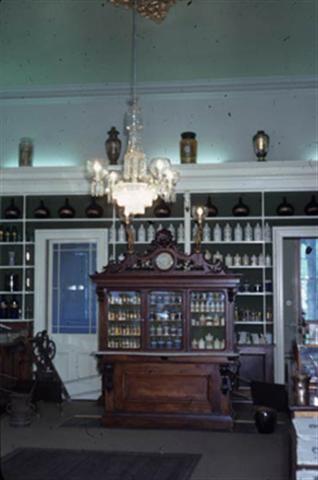 
The interior colors discovered by Stokes painstakingly scratching back to what was left on the walls also provided some surprises. First told to the average person before seeing the finished product brought rather quizzical or disbelieving looks. Behind the primary open shelving, which is white and that holds those original containers, is dark green wallpaper. That is offset by the "warm gray" walls and cornice, the pale green ceiling, and the gold medallions that add extra opulence to the chandeliers. The ordinary pine cabinets and shelving are painted white. The more exotic wood cabinets, as well as the drawers and bins, were not refinished, but merely cleaned, in part to save doing damage to those that carried the same gilt labels for their primarily botanical and chemical contents as the original jars and bottles on the shelves above. (A view of the pharmacy interior is seen below during the visit of Queen Mother Elizabeth in 1981.)
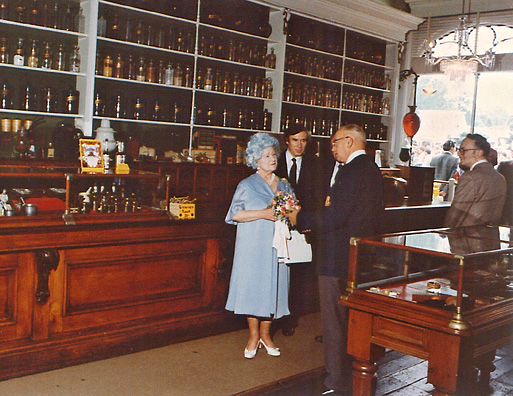
The exterior was equally grand with its large arched windows ornamented with a wooden twisted rope treatment in the then popular Italianate or Florentine style. Overall, it was and remains quite remarkable for a small town in an essentially rural setting. A large golden mortar, crafted by a local tinsmith, hangs again to bring back the original description of the earliest practice as "The Niagara Apothecary at the Sign of the Golden Mortar." That original name has been perpetuated in the restoration to avoid tying it to any one of the six pharmacist owners involved over its almost 150-year operation.
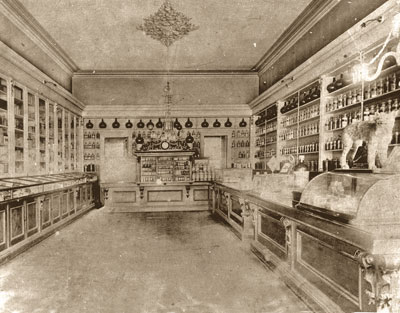
The earliest surviving photograph of the interior (above) of just after Paffard sold the practice to James DeW. Randall in 1898, is certainly priceless and proved invaluable at the time of restoring the professional practice aspects of the museum, since they showed the Harvey containers in place still in Randall's time. The photo also shows that by then gas had given way to electricity for the chandeliers, now with most of the crystal drops removed, likely because it was a dusty corner before the streets were paved.
The exterior photo of about the same time (below) is also telling since it shows local "drugstore cowboys" hanging out on their bikes in front on the corner. The sign on the side of the building already advertises gasoline, along with tobacco, Kodak (i.e. camera) supplies, postcards, candies, and sundries.
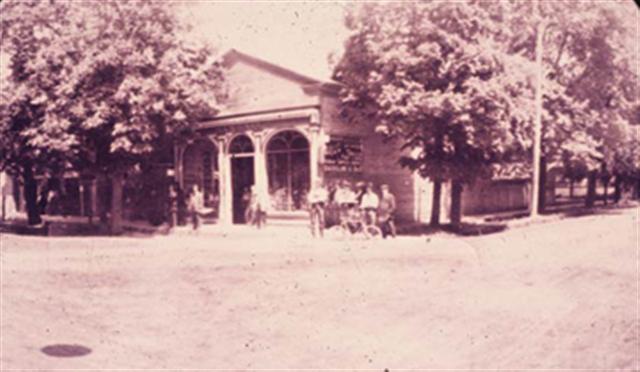
 
|


